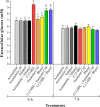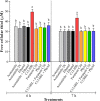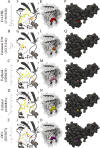Furanone and phytol influence metabolic phenotypes regulated by acyl-homoserine lactone in Salmonella
- PMID: 35947344
- PMCID: PMC9679073
- DOI: 10.1007/s42770-022-00809-y
Furanone and phytol influence metabolic phenotypes regulated by acyl-homoserine lactone in Salmonella
Abstract
Salmonella is an important foodborne pathogen, and it is unable to produce the quorum sensing signaling molecules called acyl-homoserine lactones (AHLs). However, it synthesizes the SdiA protein, detecting AHL molecules, also known as autoinducer-1 (AI-1), in the external environment. Exogenous AHLs can regulate specific genes related to virulence and stress response in Salmonella. Thus, interfering with quorum sensing can be a strategy to reduce virulence and help elucidate the cell-to-cell communication role in the pathogens' response to extracellular signals. This study aimed to evaluate the influence of the quorum sensing inhibitors furanone and phytol on phenotypes regulated by N-dodecanoyl homoserine lactone (C12-HSL) in Salmonella enterica serovar Enteritidis. The furanone C30 at 50 nM and phytol at 2 mM canceled the alterations promoted by C12-HSL on glucose consumption and the levels of free cellular thiol in Salmonella Enteritidis PT4 578 under anaerobic conditions. In silico analysis suggests that these compounds can bind to the SdiA protein of Salmonella Enteritidis and accommodate in the AHL binding pocket. Thus, furanone C30 and phytol act as antagonists of AI-1 and are likely inhibitors of the quorum sensing mechanism mediated by AHL in Salmonella.
Keywords: Furanone C30; Glucose consumption; Phytol; QS-inhibitor; Quorum sensing; Thiol.
© 2022. The Author(s) under exclusive licence to Sociedade Brasileira de Microbiologia.
Conflict of interest statement
None to declare.
Figures




Similar articles
-
Changes in the Salmonella enterica Enteritidis phenotypes in presence of acyl homoserine lactone quorum sensing signals.J Basic Microbiol. 2016 May;56(5):493-501. doi: 10.1002/jobm.201500471. Epub 2015 Dec 11. J Basic Microbiol. 2016. PMID: 26662614
-
Novel insights from molecular docking of SdiA from Salmonella Enteritidis and Escherichia coli with quorum sensing and quorum quenching molecules.Microb Pathog. 2016 Oct;99:178-190. doi: 10.1016/j.micpath.2016.08.024. Epub 2016 Aug 24. Microb Pathog. 2016. PMID: 27565088
-
N-dodecanoyl-homoserine lactone influences the levels of thiol and proteins related to oxidation-reduction process in Salmonella.PLoS One. 2018 Oct 10;13(10):e0204673. doi: 10.1371/journal.pone.0204673. eCollection 2018. PLoS One. 2018. PMID: 30304064 Free PMC article.
-
Role of the LuxR solo, SdiA, in eavesdropping on foreign bacteria.FEMS Microbiol Rev. 2025 Jan 14;49:fuaf015. doi: 10.1093/femsre/fuaf015. FEMS Microbiol Rev. 2025. PMID: 40240290 Free PMC article. Review.
-
Eavesdropping by bacteria: the role of SdiA in Escherichia coli and Salmonella enterica serovar Typhimurium quorum sensing.Foodborne Pathog Dis. 2011 Feb;8(2):169-78. doi: 10.1089/fpd.2010.0651. Epub 2010 Oct 30. Foodborne Pathog Dis. 2011. PMID: 21034261 Review.
References
-
- Santhi LP, Sunkoji S, Siddiram S, et al. Patent research in salmonellosis prevention. Food Res Int. 2012;45:809–818. doi: 10.1016/j.foodres.2011.11.006. - DOI
MeSH terms
Substances
LinkOut - more resources
Full Text Sources
Molecular Biology Databases

